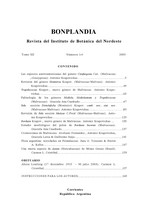Taxonomía del género Arachis (Leguminosae)
DOI:
https://doi.org/10.30972/bon.81-43559Resumen
Almost 100 years elapsed between Linnaeus' naming the then lone species of Arachis (A. hypogaea L.), known to Europeans, and the first taxonomic treatment of the genus by Benthamin 1841. During the next 100 years five to ten additional species descriptions appeared,assigning different species to the same names,different names to the same species. By mid20th century, it was impossible to examine anyherbarium collection of Arachis and assign any epithet with any assurance to any specimen (which was not a type collection) except to A. hypogaea, A. guaranitica, A. tuberosa and A. villosulicarpa. In our treatment the Iiterature of this botanical chaos in Arachis is reviewed in detail and an assessment is made of the foundations for its occurrence. It is shown that the bases for the confusion lay in the combination of the esoteric nature of the differentiating morphological features of Arachis, the fragmentary early collections and the representation of species by seedling specimens. Also, it is related how, in 1959, we decided to re-explore the type locality of each species then known, collect therein complete plant specimens and thereby resolve the problem. Thirty five years, two generations of plant collectors and around 2000 collections later we present here 69 species descriptions of Arachis, species distributed in South America east of the Andes, south of the Amazon, north of La Plata and from NW Argentina to NE Brazil. We soon discovered that the most significant characters of Arachis lay in their underground structures, including their fruits, rhizomatous stems, root systems and hypocotyls. We showed that these defining characters tended to cluster the collections into groups which were associated with generally different geographic areas and ecological features. We drew a sample of 100 collections representing these c1usters, areas and features and arranged them in a hybridization diallel and showed, in crosses between collections representing different c1usters of characters, areas and features, a remarkable number of complete failures to cross-fertilize and in those hybrids which were recovered a high degree of F1 hybrid infertility. When these cross-incompatibilities and pollen infertilities were combined with the data on character-clustering, the nine distinct sections of the genus presented here then crystallized. Figures imposed upon maps of South America iIIustrate the geographic distributions of these sections. The collections were then assigned to the different sections on the bases of crossincompatibility and exo-morphologic character clustering. When these groups were made the esoteric characteristics, referred to aboye, so confounding when applied across sectionallines, became highly pertinent when applied to the problema of species differentiation between collections within sections. These, applied in conjunction with chromosome cytology, chromatographic and antigenic reactions, variations in intra-sectional hybrid fertility and adaptations of plant form and annual and perennial habit, allowed us to assemble the following taxa of the genus Arachis: Section 1. TR/ERECTO/DES nov.: 1. A. guaranitica, 2. A. tuberosa. Section 11. ERECTO/DES nov.: 3. A. Martií, 4. A. brevipetio/ata nov., 5. A. Oteroi nov., 6. A. Hatschbach;i nov., 7. A. cryptopotamica nov., 8. A. majar nov., 9. A. Benthamií, 10. A. douradiana nov., 11. A. gracilis nov., 12. A. Hermannií nov., 13. A. Archer; nov., 14. A. stenophylla nov., 15a. A. paraguariensis subsp. paraguariensis, 15b. A. paraguariensis subsp. capibarensis nov. Section 111. EXTRANERVOSAE nov.: 16. A. setinervosa nov., 17. A. Macedoi nov., 18. A. marginata, 19. A. prostrata, 20. A. lutescens, 21. A. retusa nov., 22. A. Burchellii nov., 23. A. Pietrarellii nov., 24. A. villosulicarpa. Section IV. TRISEMINATAE nov.: 25. A. triseminata nov.. Section V. HETERANTHAE nov.: 26. A. Giacomettii nov., 27. A. sylvestris, 28. A. pusilla, 29. A. Dardani nov. Section VI CAULORRHIZAE nov.: 30. A. repens, 31. A. Pintoi nov.. Section VII. PROCUMBENTES nov.: 32. A. lignosa nov. comb., 33. A. Kretschmeri nov., 34. A. Rigonii, 35. A. chiquitana nov., 36. A. matiensis nov., 37. A. appressipi/a nov., 38. A. Vallsii nov., 39. A. subcoriacea nov. Section VIII. RHIZOMATOSAEnov., Series. PRORHIZOMATOSAEnov.: 40. A. Burkartii. Series. RHIZOMATOSAE nov.: 41. A. pseudovillosa nov. comb., 42a. A. glabrata varo glabrata, 42b. A. glabrata varo Hagenbeckii. Section IX. ARACHIS: 43. A. glandulifera, 44. A. cruziana nov., 45. A. monticola, 46. A. magna nov., 47. A. ipaensis nov., 48. A. valida nov., 49. A. Williamsii nov., 50. A. Batizocoi, 51. A. duranensis nov., 52. A. Hoehnei nov., 53. A. stenosperma nov., 54. A. praecox nov., 55. A. palustris nov., 56. A. benensis nov., 57. A. trinitensis nov., 58. A. decora nov., 59. A. Herzogii nov., 60. A. microsperma nov., 61. A. vil/osa, 62. A. helodes, 63. A. correntina nov. comb., 64. A. Simpsonii nov., 65. A. Cardenasii nov., 66. A. Kempff-Mercadoi nov., 67. A. Diogoi, 68. A. Kuhlmannii nov., 69a. A hypogaea subsp. hypogaea varo 1. hypogaea, var.2. hirsuta, 69b. A. hypogaea subsp. fastigiata var.1. fastigiata, var.2. peruviana nov., var.3. aequatoriana nov., varA. vulgaris. .The autogamous reproductive systems, agametic reproduction, underground fruiting habit and the limited means of seed dispersal are shown to be logically tied to the drift in chromosomal organization which gives rise to noticeable increases in infertility in crosses between different collections of the same species, to a variably higher infertility in crosses between species within sections, to a near total infertility in crosses between species from different sections. The evolutionary and phylogenetic relationships between the different sections are discussed and are further shown in a sequence of diagrams illustrating ideas presented. It is evident that the genetic distances separating the sections are far from being of the same magnitude.
The presumably older (Triseminatae, Trierectoides, Erectoides, Extranervosae, and Heteranthae sections, except for section Erectoides, are much more isolated from the remaining sections and each other than those taken to be of more recent origin (Procumbentes, Caulorrhizae, Rhizomatosae, and Arachis). Arachis section is by far the largest section, containing about 40% of the species described. Species of the section appearto be spreading to newterritory and to be invading areas occupied by species of other sections. They grow intermixed with populations of Extranervosae in the. upper Paraguay basin and occupy common ground with section Procumbentes in the Gran Pantanal. They have reached the shores of La Plata and the southeastern coast of Brazil and grow from Yala in NW Argentina to the Tocantins in NE Brazil. They contain the world-wide cultivar A. hypogaea. Essentially every published work on the botanical history and taxonomy of Arachis is presented in individual specimen references and in the general bibliography. The history of A. hypogaea from the early 16th century to more recent times along with the common names in several native American languages provide a perspective on the antiquity of this cultivar and the level of civilization required for its creation. Six appendices provide supporting data and matters of record. Diagnostic keys to the sections and to the species within each section select the more sharply distinguishing guides
to the sections and species. Nineteen line drawings capture the sectional and species structures of whole plants, root systems, fruit orientations, agametic reproductions from fruiting structures, carpel shapes and surface features of leaves and stems.
Descargas
Descargas
Publicado
Versiones
- 2023-11-16 (2)
- (1)
Cómo citar
Número
Sección
Licencia
Derechos de autor 2018 Bonplandia

Esta obra está bajo una licencia internacional Creative Commons Atribución 4.0.
Declaration of Adhesion to Open Access
- All contents of Bonplandia journal are available online, open to all and for free, before they are printed.
Copyright Notice
- Bonplandia magazine allows authors to retain their copyright without restrictions.
- The journal is under a Creative Commons Attribution 4.0 International license.















.jpg)


